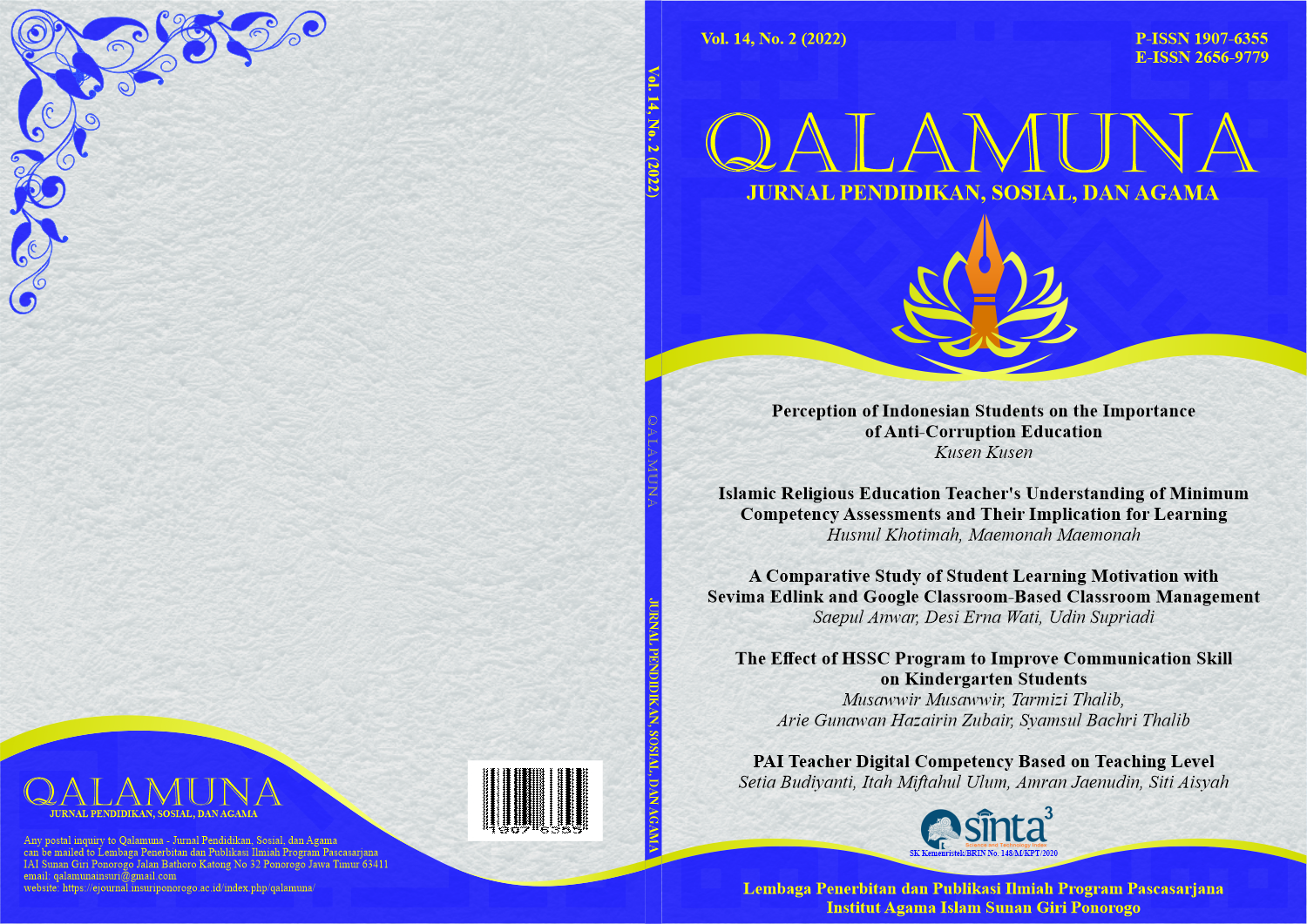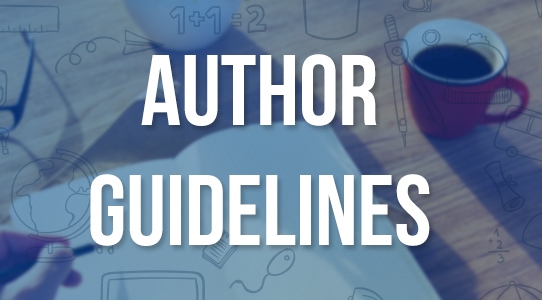Development of Interactive Video Media to Improve Students' Speaking Skills
DOI:
https://doi.org/10.37680/qalamuna.v14i2.3703Keywords:
English Teaching Material, Material Development, Speaking Proficiency, Interactive VideoAbstract
This study intends to identify the requirements of students and teachers for enhancing speaking skills and validate the use of interactive video in the classroom. This study used the ADDIE model's research and development (R&D) methodology: analysis, design, development, implementation, and evaluation. Thus, it validated the teacher's material requirements and analyzed the students' needs. This study includes three English instructors and 18 secondary school students from MTS Miftahul Ulum Lumajang. Observation of classes, interviews, and questionnaires were utilized to collect data for this study. However, an interview revealed that the teacher frequently encountered difficulties devising English material for the junior high school class, particularly for the eighth grade, due to students' asking and expressing opinions. This study revealed, through a questionnaire, that the majority of teachers (66.7%) had difficulty enhancing students' speaking abilities by asking and giving opinions. This study revealed that the majority of students (72.2%) struggle to develop their speaking skills through asking and responding. Therefore, interactive video must be utilized. This study has provided the majority of teachers with a positive perspective on the effectiveness of interactive videos in enhancing speaking proficiency.
References
Benkada, C., & Moccozet, L. (2017). Enriched interactive videos for teaching and learning. 2017 21st International Conference Information Visualisation (IV), 344–349.
Desiningrum, N., Mustaji, M., Mariono, A., & Nuryasana, E. (2019). The development of teaching materials of learning technology based on character building. Research, Society and Development, 8(8), e28881217–e28881217.
Dewi, Y. N., Zaim, M., & Rozimela, Y. (2022). Interactive learning using e-learning module in learning English for senior high school: A review of related articles. JELITA: Journal of Education, Language Innovation, and Applied Linguistics, 1(2), 125–134.
Fitrah, R. A., & Juita, N. (2022). The Use of Non-Comparative Figure of Speech in The Snack Advertisements on Indonesian Television as The Learning Materials in School. QALAMUNA: Jurnal Pendidikan, Sosial, Dan Agama, 14(2), 467–490.
Hariyadi, A., & Yanti, D. R. (2019). The importance of needs analysis in materials development. Jurnal Ilmiah Profesi Pendidikan, 4(2), 94–99.
Harmer, J. (2001). The practice of English language teaching. London/New York, 401–405.
Hussin, R. A., Gani, S. A., & Muslem, A. (2020). The use of YouTube media through group discussion in teaching speaking. English Education Journal, 11(1), 19–33.
Irkinovich, N. R. (2022). THE IMPORTANCE OF ROLE-PLAYING GAMES IN TEACHING ENGLISH IN A NON-LINGUISTIC UNIVERSITY. International Journal of Pedagogics, 2(09), 29–32.
Jaelani, A., & Zabidi, O. W. (2020). Junior high school studentsâ€TM difficulties of English language learning in the speaking and listening section. ELT Forum: Journal of English Language Teaching, 9(1), 45–54.
Littlejohn, A. (2012). Language teaching materials and the (very) big picture. Electronic Journal of Foreign Language Teaching, 9(1), 283–297.
Matić, L. J. (2019). The teacher as a lesson designer. Center for Educational Policy Studies Journal, 9(2), 139–160.
Munawaroh, N. (2017). The influence of teaching methods and learning environment to the student’s learning achievement of craft and entrepreneurship subjects at vocational high school. International Journal of Environmental & Science Education, 12(4), 665–678.
Munna, A. S., & Kalam, M. A. (2021). Teaching and learning process to enhance teaching effectiveness: a literature review. International Journal of Humanities and Innovation (IJHI), 4(1), 1–4.
Ningsih, F., Ikhsanudin, I., & Arifin, Z. (n.d.). USING ENGLISH VIDEO CONVERSATION “ASKING AND GIVING OPINION” TO IMPROVE STUDENTS’SPEAKING ABILITY. Jurnal Pendidikan Dan Pembelajaran Khatulistiwa (JPPK), 7(10).
Niswatun, N., & Franzhardi, D. (2022). The Students’ Ability in Using Asking and Giving Opinion Expression to Develop Speaking Skill at The Ninth Grade Students of MTs PSM Suka Agung Buay Bahuga Way Kanan. ENJEL: English Journal of Education and Literature, 1(1), 7–13.
Ordu, U. B.-A. (2021). The Role of Teaching and Learning Aids/Methods in a Changing World. Bulgarian Comparative Education Society.
Prasasti, I. H., Baihaqi, Y., & Hakim, A. R. (2022). The Use of Instagram to Boost Students’ Writing Skill In Explanation Text. Jurnal Locus Penelitian Dan Pengabdian, 1(1), 1–6.
Puspitarini, Y. D., & Hanif, M. (2019). Using Learning Media to Increase Learning Motivation in Elementary School. Anatolian Journal of Education, 4(2), 53–60.
Putra, A. S. (2017). The correlation between motivation and speaking ability. Channing: Journal of English Language Education and Literature, 2(1), 36–57.
Putri, D. A., Desyandri, D., Adnan, F., & Fitria, Y. (2022). The Development Of E-Module Based On Discovery Learning In Theme 5 At Grade IV Elementary School. QALAMUNA: Jurnal Pendidikan, Sosial, Dan Agama, 14(2), 549–566.
Rahayuningsih, D. (2016). STUDENT TEACHERS’CHALLENGES IN DEVELOPING TEACHING MATERIALS DURING TEACHING PRACTICUM IN VOCATIONAL SCHOOL. Journal of English and Education, 4(2), 24–34.
Riswandi, D. (2016). Use of YouTube-based videos to improve students’ speaking skill. Proceeding of the International Conference on Teacher Training and Education, 2(1), 298–306.
Rizki, J. W. S. (2023). Social Media as Tools of Communication and Learning. QALAMUNA: Jurnal Pendidikan, Sosial, Dan Agama, 15(1), 391–404.
Rokhayati, T., & Widiyanti, A. (2022). Using technology-based media for teaching speaking in intercultural education. Lingua Cultura, 16(1), 9–15.
Wardani, R. K., Elfisa, Y., & Andriani, D. (2020). AN ANALYSIS SPEAKING ABILITY OF USING ASKING AND GIVING OPINION AT EIGHT GRADE OF SMP N 22 MERANGIN ACADEMICYEAR 2019/2020. Selecting, 2(2), 49–56.
Widodo, J. (2022). Development of Interactive Teaching Materials in Indonesian for Grade VI Elementary School Students. Qalamuna-Jurnal Pendidikan, Sosial, Dan Agama, 14(2), 383–400.
Zaitun, Z., Hadi, M. S., & Indriani, E. D. (2021). TikTok as a Media to Enhancing the Speaking Skills of EFL Student’s. Jurnal Studi Guru Dan Pembelajaran, 4(1), 89–94.
Downloads
Published
How to Cite
Issue
Section
License
Authors who submit manuscript retain its copyright and grant publisher right of first publication licensed under a Creative Commons Attribution-ShareAlike 4.0 International License (CC BY-SA 4.0) that allows others to access (search, read, download, and cite), share (copy and redistribute the material in any medium or format) and adapt (remix, transform, and build upon any material) the work for any lawful purpose, even commercially with an acknowledgement of the work's authorship and initial publication in Qalamuna: Jurnal Pendidikan, Sosial, dan Agama.












